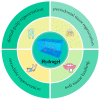Hydrogels for Oral Tissue Engineering: Challenges and Opportunities
- PMID: 37175356
- PMCID: PMC10179962
- DOI: 10.3390/molecules28093946
Hydrogels for Oral Tissue Engineering: Challenges and Opportunities
Abstract
Oral health is crucial to daily life, yet many people worldwide suffer from oral diseases. With the development of oral tissue engineering, there is a growing demand for dental biomaterials. Addressing oral diseases often requires a two-fold approach: fighting bacterial infections and promoting tissue growth. Hydrogels are promising tissue engineering biomaterials that show great potential for oral tissue regeneration and drug delivery. In this review, we present a classification of hydrogels commonly used in dental research, including natural and synthetic hydrogels. Furthermore, recent applications of these hydrogels in endodontic restorations, periodontal tissues, mandibular and oral soft tissue restorations, and related clinical studies are also discussed, including various antimicrobial and tissue growth promotion strategies used in the dental applications of hydrogels. While hydrogels have been increasingly studied in oral tissue engineering, there are still some challenges that need to be addressed for satisfactory clinical outcomes. This paper summarizes the current issues in the abovementioned application areas and discusses possible future developments.
Keywords: dental pulp; hydrogels; mandible; periodontium; tissue engineering.
Conflict of interest statement
The authors declare no conflict of interest.
Figures







Similar articles
-
Recent Advances in Functional Hydrogels for Treating Dental Hard Tissue and Endodontic Diseases.ACS Nano. 2024 Jul 2;18(26):16395-16412. doi: 10.1021/acsnano.4c02754. Epub 2024 Jun 14. ACS Nano. 2024. PMID: 38874120 Review.
-
Research Progress on the Application of Injectable Hydrogel in Oral Tissue Regeneration.J Oral Pathol Med. 2024 Nov;53(10):605-612. doi: 10.1111/jop.13581. Epub 2024 Sep 26. J Oral Pathol Med. 2024. PMID: 39327673 Review.
-
Heparin-functionalized polymeric biomaterials in tissue engineering and drug delivery applications.Acta Biomater. 2014 Apr;10(4):1588-600. doi: 10.1016/j.actbio.2013.07.031. Epub 2013 Aug 2. Acta Biomater. 2014. PMID: 23911941 Free PMC article. Review.
-
Tailored Biomaterials for Therapeutic Strategies Applied in Periodontal Tissue Engineering.Stem Cells Dev. 2019 Aug 1;28(15):963-973. doi: 10.1089/scd.2019.0016. Epub 2019 May 24. Stem Cells Dev. 2019. PMID: 31020906 Review.
-
Suitability of Different Natural and Synthetic Biomaterials for Dental Pulp Tissue Engineering.Tissue Eng Part A. 2018 Feb;24(3-4):234-244. doi: 10.1089/ten.TEA.2016.0555. Epub 2017 Jul 20. Tissue Eng Part A. 2018. PMID: 28537502
Cited by
-
Multifunctional Hydrogels Based on Cellulose and Modified Lignin for Advanced Wounds Management.Pharmaceutics. 2023 Nov 4;15(11):2588. doi: 10.3390/pharmaceutics15112588. Pharmaceutics. 2023. PMID: 38004566 Free PMC article.
-
Azithromycin-Loaded Nanoparticles Incorporated in Chitosan-Based Soft Hydrogels: A Novel Approach for Dental Drug Delivery.Pharmaceutics. 2025 Feb 26;17(3):304. doi: 10.3390/pharmaceutics17030304. Pharmaceutics. 2025. PMID: 40142968 Free PMC article.
-
Exosome-Laden Hydrogels as Promising Carriers for Oral and Bone Tissue Engineering: Insight into Cell-Free Drug Delivery.Int J Mol Sci. 2024 Oct 15;25(20):11092. doi: 10.3390/ijms252011092. Int J Mol Sci. 2024. PMID: 39456873 Free PMC article. Review.
-
Unraveling the New Perspectives on Antimicrobial Hydrogels: State-of-the-Art and Translational Applications.Gels. 2023 Jul 29;9(8):617. doi: 10.3390/gels9080617. Gels. 2023. PMID: 37623072 Free PMC article. Review.
-
Bioactive injectable mucoadhesive thermosensitive natural polymeric hydrogels for oral bone and periodontal regeneration.Front Bioeng Biotechnol. 2024 May 28;12:1384326. doi: 10.3389/fbioe.2024.1384326. eCollection 2024. Front Bioeng Biotechnol. 2024. PMID: 38863491 Free PMC article. Review.
References
Publication types
MeSH terms
Substances
Grants and funding
- 52003057/National Natural Science Foundation of China
- 82201039/National Natural Science Foundation of China
- FS0AA-KJ919-4402-0145/Foshan Science and Technology Innovation Project
- 564022/MRC-UCL Therapeutic Acceleration Support (TAS) Fund
- 564021/NIHR UCLH BRC-UCL Therapeutic Acceleration Support (TAS) Fund
LinkOut - more resources
Full Text Sources

